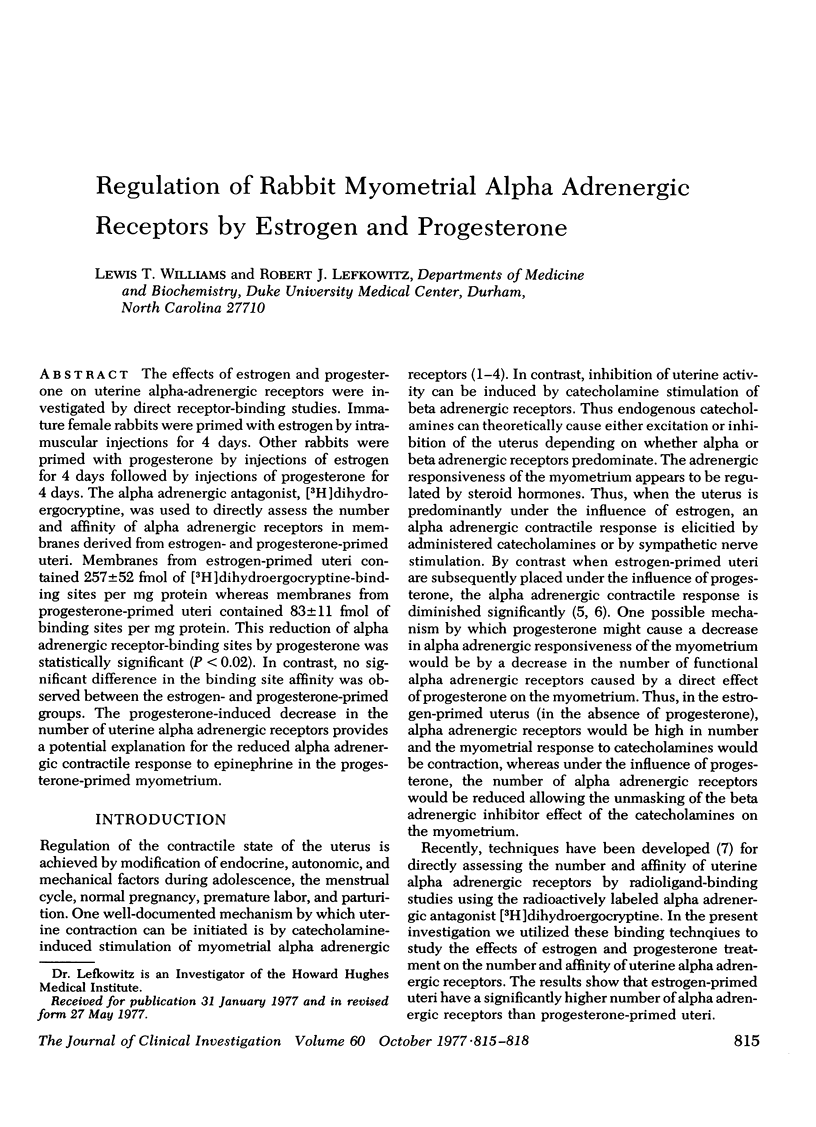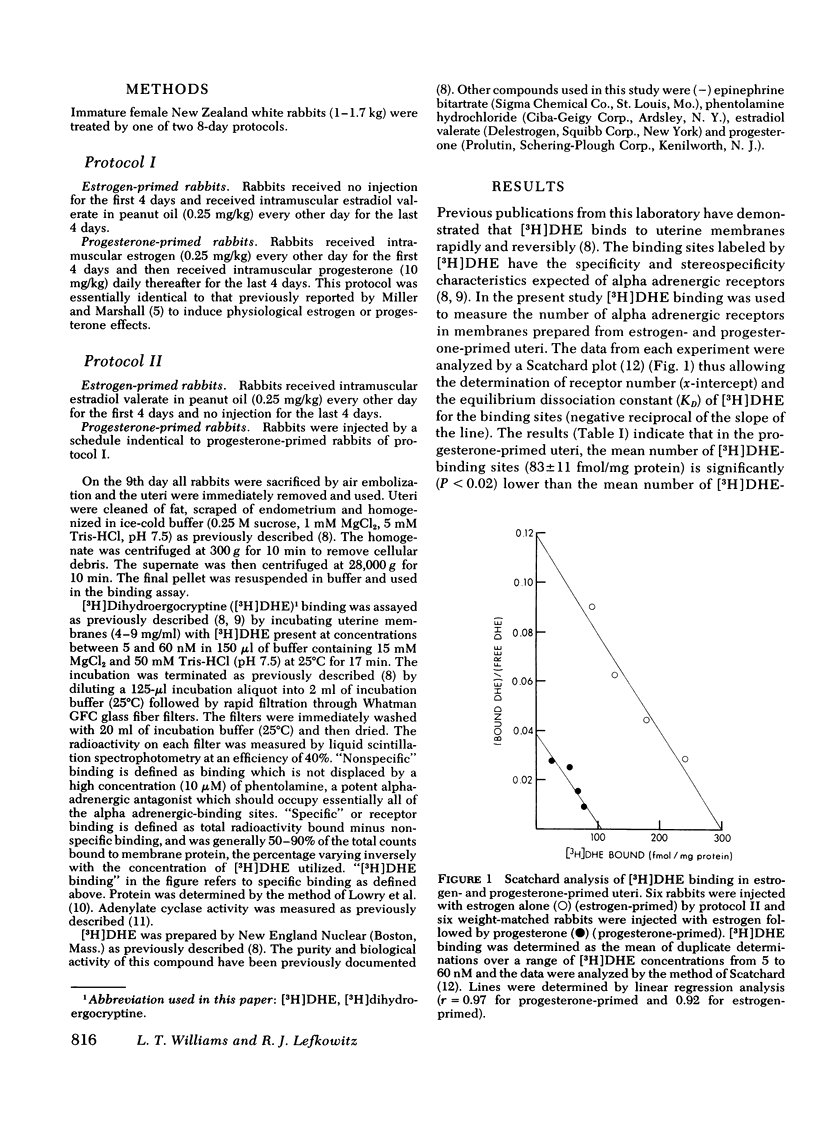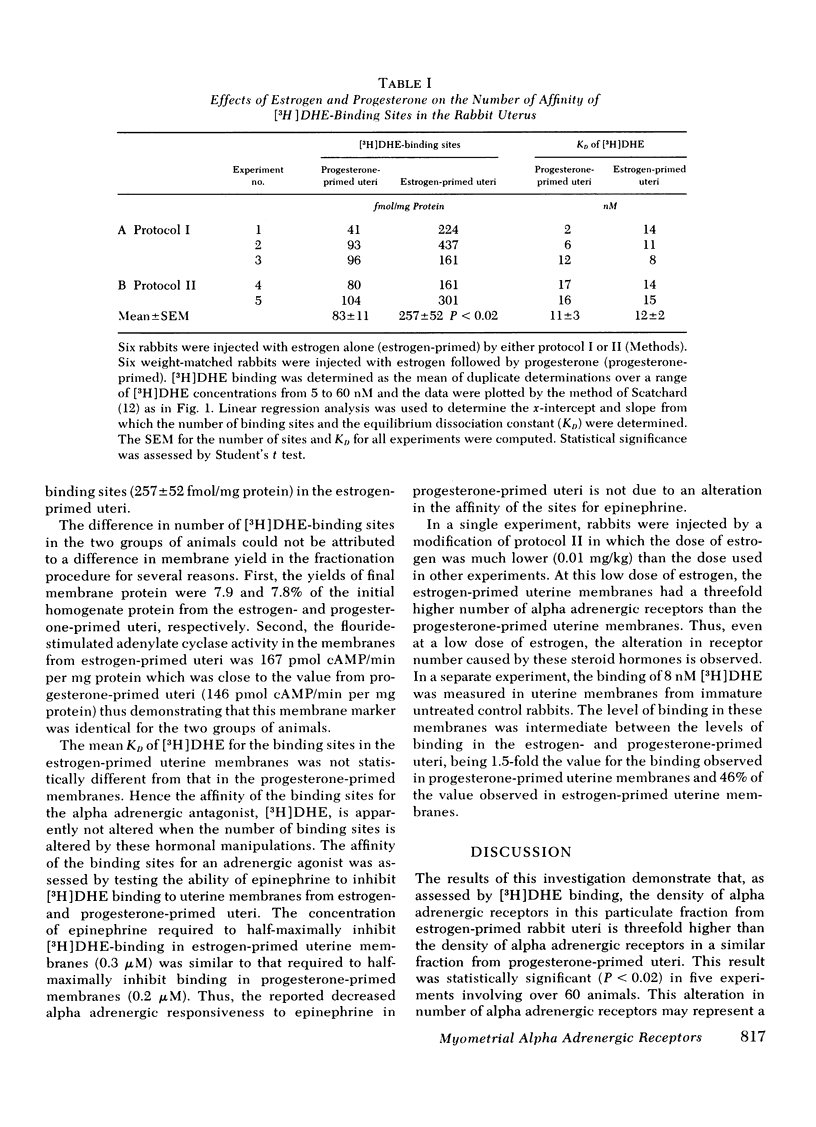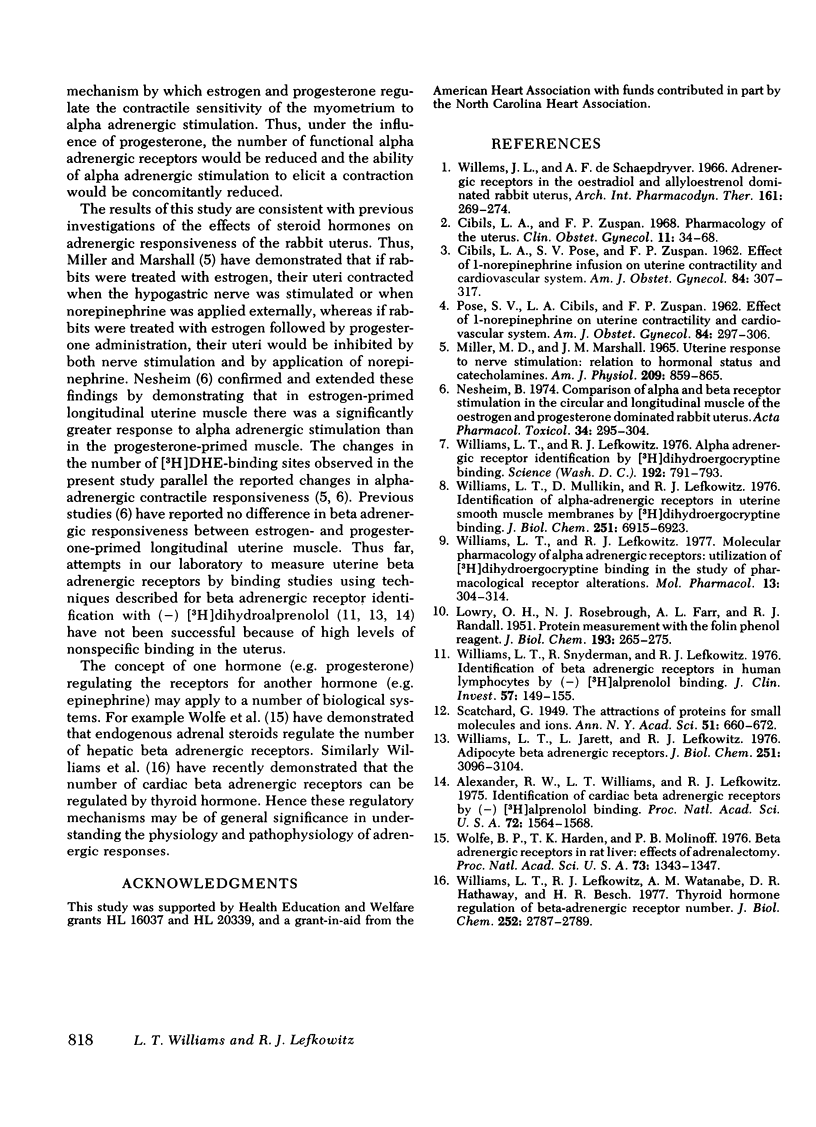Abstract
The effects of estrogen and progesterone on uterine alpha-adrenergic receptors were investigated by direct receptor-binding studies. Immature female rabbits were primed with estrogen by intramuscular injections for 4 days. Other rabbits were primed with progesterone by injections of estrogen for 4 days followed by injections of progesterone for 4 days. The alpha adrenergic antagonist, [3H]dihydroergocryptine, was used to directly assess the number and affinity of alpha adrenergic receptors in membranes derived from estrogen-and progesterone-primed uteri. Membranes from estrogen-primed uteri contained 257 +/- 52 fmol of [3H]dihydroergocryptine-binding sites per mg protein whereas membranes from progesterone-primed uteri contained 83 +/- 11 fmol of of binding sites per mg protein. This reduction of alpha adrenergic receptor-binding sites by progesterone was statistically significant (P less than 0.02). In contrast, no significant difference in the binding site affinity was observed between the estrogen- and progesterone-primed groups. The progesterone-induced decrease in the number of uterine alpha adrenergic receptors provides a potential explanation for the reduced alpha adrenergic contractile response to epinephrine in the progesterone-primed myometrium.
Full text
PDF



Selected References
These references are in PubMed. This may not be the complete list of references from this article.
- Alexander R. W., Williams L. T., Lefkowitz R. J. Identification of cardiac beta-adrenergic receptors by (minus) [3H]alprenolol binding. Proc Natl Acad Sci U S A. 1975 Apr;72(4):1564–1568. doi: 10.1073/pnas.72.4.1564. [DOI] [PMC free article] [PubMed] [Google Scholar]
- CIBILS L. A., POSE S. V., ZUSPAN F. P. Effect of 1-norepinephrine infusion on uterine contractility and cardiovascular system. Am J Obstet Gynecol. 1962 Aug 1;84:307–317. doi: 10.1016/0002-9378(62)90127-8. [DOI] [PubMed] [Google Scholar]
- Cibils L. A., Zuspan F. P. Pharmacology of the uterus. Clin Obstet Gynecol. 1968 Mar;11(1):34–68. doi: 10.1097/00003081-196803000-00003. [DOI] [PubMed] [Google Scholar]
- LOWRY O. H., ROSEBROUGH N. J., FARR A. L., RANDALL R. J. Protein measurement with the Folin phenol reagent. J Biol Chem. 1951 Nov;193(1):265–275. [PubMed] [Google Scholar]
- Miller M. D., Marshall J. M. Uterine response to nerve stimulation; relation to hormonal status and catecholamines. Am J Physiol. 1965 Nov;209(5):859–865. doi: 10.1152/ajplegacy.1965.209.5.859. [DOI] [PubMed] [Google Scholar]
- Nesheim B. I. Comparison of alpha- and beta-receptor stimulation in the circular and longitudinal muscle of the oestrogen and progesterone dominated rabbit uterus. Acta Pharmacol Toxicol (Copenh) 1974 Apr;34(4):295–304. doi: 10.1111/j.1600-0773.1974.tb03526.x. [DOI] [PubMed] [Google Scholar]
- POSE S. V., CIBILS L. A., ZUSPAN F. P. Effect of 1-epinephrine infusion on uterine contractility and cardiovascular system. Am J Obstet Gynecol. 1962 Aug 1;84:297–306. doi: 10.1016/0002-9378(62)90126-6. [DOI] [PubMed] [Google Scholar]
- Willems J. L., De Schaepdryver A. F. Adrenergic receptors in the oestradiol and allyl-oestrenol dominated rabbit uterus. Arch Int Pharmacodyn Ther. 1966 Jun;161(2):269–274. [PubMed] [Google Scholar]
- Williams L. T., Jarett L., Lefkowitz R. J. Adipocyte beta-adrenergic receptors. Identification and subcellular localization by (-)-[3H]dihydroalprenolol binding. J Biol Chem. 1976 May 25;251(10):3096–3104. [PubMed] [Google Scholar]
- Williams L. T., Lefkowitz R. J. Alpha-adrenergic receptor identification by (3H)dihydroergocryptine binding. Science. 1976 May 21;192(4241):791–793. doi: 10.1126/science.4894. [DOI] [PubMed] [Google Scholar]
- Williams L. T., Lefkowitz R. J. Molecular pharmacology of alpha adrenergic receptors: utilization of [3H]dihydroergocryptine binding in the study of pharmacological receptor alterations. Mol Pharmacol. 1977 Mar;13(2):304–313. [PubMed] [Google Scholar]
- Williams L. T., Lefkowitz R. J., Watanabe A. M., Hathaway D. R., Besch H. R., Jr Thyroid hormone regulation of beta-adrenergic receptor number. J Biol Chem. 1977 Apr 25;252(8):2787–2789. [PubMed] [Google Scholar]
- Williams L. T., Mullikin D., Lefkowitz R. J. Identification of alpha-adrenergic receptors in uterine smooth muscle membranes by [3H]dihydroergocryptine binding. J Biol Chem. 1976 Nov 25;251(22):6915–6923. [PubMed] [Google Scholar]
- Williams L. T., Snyderman R., Lefkowitz R. J. Identification of beta-adrenergic receptors in human lymphocytes by (-) (3H) alprenolol binding. J Clin Invest. 1976 Jan;57(1):149–155. doi: 10.1172/JCI108254. [DOI] [PMC free article] [PubMed] [Google Scholar]
- Wolfe B. B., Harden T. K., Molinoff P. B. beta-adrenergic receptors in rat liver: effects of adrenalectomy. Proc Natl Acad Sci U S A. 1976 Apr;73(4):1343–1347. doi: 10.1073/pnas.73.4.1343. [DOI] [PMC free article] [PubMed] [Google Scholar]


